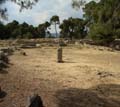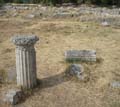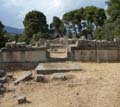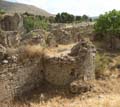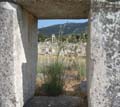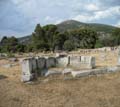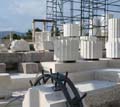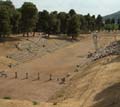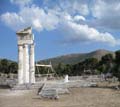
(tel. 27530 23009, 27530 22666)
The Asclepius of Epidaurus was the most famous Asclepius sanctuary in antiquity, with subsidiary sanctuaries in Athens, Kos and Rome. Official sanctuary of Epidaurus, religious and national center of Epidauria whose function goes back to the 6th century BC. Very closely connected with the originally Mycenaean sanctuary of Apollo Maleata, which was destroyed in the 1st c. BC. At the site of the sanctuary of Apollo Maleata, on the northern slope of Mount Kynorti, parts of a proto-Hellenic settlement (3rd millennium BC). Mycenaean summit sanctuary (1500 - 1200 BC), one of the few in the Greek area, is associated with outdoor worship activity.
In the sanctuary of Maleata, a monumental monument of the 3rd c. BC, it supports a portico, possibly a sleeping place (a place where the god appeared to the patients and indicated or performed their treatment), ruins of the classical temple in the place of the older archaic one, open-air altar, sacrificial urn of the Mycenaean and Roman times, built altar ( 4th century BC) in the square of the sanctuary and outdoor mosque of the Muses. The propylon of the sanctuary and an extensive complex outside its boundaries with a bath, fountain and reservoir belong to the Roman times. In the sanctuary of Asclepius, today an organized archaeological site that also includes the ancient theater, the ruined buildings of the 4th - 3rd centuries BC can be visited and Roman imperial times.
The main buildings are the Doric temple of Asclepius (its sculptural architectural decoration in the National Archaeological Museum), the arcade-shaped abattoir or "burial ground", the square complex of the 5th c. BC which surrounded the oldest relics of the cult of Apollo and Asclepius. Finally, the dome (thymeli), famous for the wealth of its architectural decoration, is a circular building with underground corridors-rings and with a combination of Ionic and Corinthian style. It was probably dedicated to the chthonic cult of Asclepius. It was probably the work of the younger Polykleitos, architect of the theater of the sanctuary and sculptor. Temples of Artemis, Aphrodite, Themis, Anakeio (sanctuary of the Dioscours), Epidoteon (sanctuary of the Epidote gods such as Sleep) and sanctuaries of Apollo and Asclepius, worshiped according to the Egyptian standard. Stadium with vaulted passageway, palaestra, baths, thermal baths and library, arcades and shelter (guest house). Gymnasium or ceremonial restaurant with a monumental propylon, in the peristyle courtyard of which a conservatory was built in Roman times.
The theater on the northwestern slope of Kynorti with the best acoustics in antiquity (4th - 3rd and 2nd centuries BC), has been restored and is in use today. The monumental double doors in the passageways are characteristic. In the local Museum, which displays inscriptions, medical tools, sculptured votives, the bases of which abound in the sanctuary, and restored parts of the spires of the Propylaea and the temples of Asclepius and Artemis. Also on display is a Corinthian capital that served as a model for those of the Dome. East of the propylaea of the sanctuary of Asclepios, remains of a five-aisled basilica with a transversal aisle, a baptistery and additions (first half of the 5th century). Mosaic floor in the narthex with geometric decoration. Inside the temple of Asclepios, ruins of a house with mosaic floors (mid 5th c.).
Source: MINISTRY OF AEGEAN
http://media.yen.gr/atlas/










